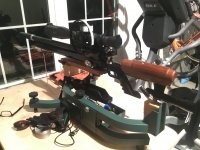I think I’m missing an obvious solution but can’t put my finger on it.
Using a March HM 10-60x56 scope (an couple of years old, not the newer one with the thermal compensation) for field target which is an air rifle discipline that uses the parallax of a scope to range targets from 10-55 yds.
During overcast days the POI is where I ranged it since I set up the scope during overcast weather, so when the scope ranges 50 yds I set the elevation to hit there and it does.
When the sun comes out the scope ranges targets way differently...on the farther targets, say 50 yds, it ranges more like 40 yds so if I set the elevation to correspond with the parallax range the POI is low. I can compensate for this on my home course as I know the distances of my targets but it’s more difficult at a match.
This is irrespective of temperature...the ranged distance doesn’t seem to change with temp, just with brightness although I know thermal expansion affects the scope as well (which is why I have a new HM on order), not sure if there’s a way to compensate for it since the change in POI differs somewhat with intensity of light and I’d like to be able to use hard data not just guess and use Kentucky windage, so to speak.
Any help appreciated.
Using a March HM 10-60x56 scope (an couple of years old, not the newer one with the thermal compensation) for field target which is an air rifle discipline that uses the parallax of a scope to range targets from 10-55 yds.
During overcast days the POI is where I ranged it since I set up the scope during overcast weather, so when the scope ranges 50 yds I set the elevation to hit there and it does.
When the sun comes out the scope ranges targets way differently...on the farther targets, say 50 yds, it ranges more like 40 yds so if I set the elevation to correspond with the parallax range the POI is low. I can compensate for this on my home course as I know the distances of my targets but it’s more difficult at a match.
This is irrespective of temperature...the ranged distance doesn’t seem to change with temp, just with brightness although I know thermal expansion affects the scope as well (which is why I have a new HM on order), not sure if there’s a way to compensate for it since the change in POI differs somewhat with intensity of light and I’d like to be able to use hard data not just guess and use Kentucky windage, so to speak.
Any help appreciated.


